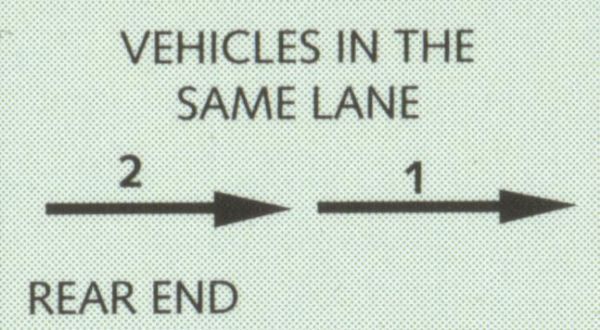





Rear End
A rear end crash involves one vehicle or road user running in to the back of another vehicle or road user. This can occur when the front vehicle slows down or stops, or because the following vehicle is travelling faster than the front vehicle.
This is a common crash type, although the severity is often less than for other crash types because the relative speeds of vehicles involved in a rear end collision are generally lower, as they are travelling in the same direction. Also, they frequently occur after both vehicles have undertaken braking action, and thus any secondary impact with the surrounding road environment is less severe.
They can be more serious in nature when vehicles of different mass come in to contact (e.g. car and bicyclist, truck and car). The problem is aggravated as passenger vehicles are often not designed with a rear crumple zone. As a result, passengers sitting at the back could experience the full impact force when collided from the rear. Where a truck fails to stop due to braking problems on downhill gradient, it could crush a car or bus when colliding from the rear and lead to severe casualties.
On motorways, stranded vehicles can cause rear end crash, particularly if they remain stationary on the traffic lane. Maintenance vehicles and workers are also prone to rear-end collision, particularly since works with lane closure are often carried out at night.
The main causes of a rear end crash are a failure to leave a sufficient gap to the vehicle in front, or a lack of attention. In both cases, there may be insufficient time to brake to avoid a collision. The time needed by the driver or rider to make a decision and brake is an important factor and will vary according to the driving conditions, speed and the road environment.
Typical factors which may add to rear end crash risk include:
- Inappropriate speeds.
- Poor pavement skid resistance.
- Roadside activity and poorly managed parking.
- Unexpected intersection or traffic queue preceded by long length of road in high speed, free-flow condition.
- Unstable traffic flow on a high speed road (e.g. sudden stops on some roads during busy periods).
- Intersections at the bottom section of roads on steep grades.
- Driver/rider fatigue.
- Alcohol/drugs/medication impairment.
- Distraction, including inattention due to mobile phone use.
- Lack of vehicle safety devices.
- Poor condition of vehicle tyres, lights, brakes and brake lights.
Case Studies
| Name | Cost rating | Effectiveness |
|---|---|---|
| Additional Lane | High | 25 – 40% |
| Central Turning Lane Full Length | Low | 10 – 25% |
| Delineation | Low | 10 – 25% |
| Intersection – Delineation | Low | 10 – 25% |
| Intersection – Grade Separation | High | 25 – 40% |
| Intersection – Turn Lanes (Signalised) | Low to Medium | 10 – 25% |
| Intersection – Turn Lanes (Unsignalised) | Low to Medium | 10 – 25% |
| One Way Network | Medium | 25 – 40% |
| Parking Improvements | Low to Medium | 10 – 25% |
| Regulate Roadside Commercial Activity | Low to Medium | 10 – 25% |
| Restrict/Combine Direct Access Points | Medium to High | 25 – 40% |
| Paved Shoulder | Medium | 25 – 40% |
| Skid Resistance | Low to Medium | 25 – 40% |
| Speed Management | Medium | 25 – 40% |
| Traffic Calming | Medium to High | 25 – 40% |
| Name | Cost rating | Effectiveness |
|---|---|---|
| Motor Vehicle Standards | – | – |
| New Car Assessment Program (NCAP) | – | – |
| Used Car Safety Ratings | – | – |
| Safety Features and Devices | – | – |
| Vehicle Roadworthiness | – | – |
| Name | Cost rating | Effectiveness |
|---|---|---|
| Addressing Alcohol and Other Drugs | – | – |
| Education | – | – |
| Enforcement | – | – |
| Fatigue Management | – | – |
| Helmets and Protective Clothing | – | – |
| Licensing | – | – |
| Publicity | – | – |
| Safe Speed | – | – |
| Seatbelts | – | – |
Related Images
 A read end crash. Image credit: iStock
A read end crash. Image credit: iStock Motorcyclist Star Ratings by road user type based on a 358,000km sample of roads across 54 countries. Image credit: iRAP
Motorcyclist Star Ratings by road user type based on a 358,000km sample of roads across 54 countries. Image credit: iRAP Vehicle occupant Star Ratings by road user type based on a 358,000km sample of roads across 54 countries. Image credit: iRAP
Vehicle occupant Star Ratings by road user type based on a 358,000km sample of roads across 54 countries. Image credit: iRAP Rear End graphic
Rear End graphic Scene of a fatal rear-end crash on the Mumbai-Pune Expressway India. Image credit: JP Research India
Scene of a fatal rear-end crash on the Mumbai-Pune Expressway India. Image credit: JP Research India The aftermath of a head on crash in Bangladesh. Image credit: Greg Smith
The aftermath of a head on crash in Bangladesh. Image credit: Greg Smith The result of a read end crash. Image credit: Greg Speier
The result of a read end crash. Image credit: Greg Speier








